Shrouded by the wooded shoulder of a busy blacktop road, a forgotten mill dam retains the flow of a small stream — and the fading summer memories of generations of truant children.
Only by risking a quick glance across a curving lane of oncoming traffic can passersby catch a glimpse of Susterka Lake, as it lies oddly perched above the deep, steep valley of the Huron River, its waters temporarily detained.
Today, Susterka Lake is only a place name, but once, it was a place — one that everyone in the area knew.
A meeting place
Located near Belleville, Michigan, at approximately 50667 W. Huron River Drive, Susterka Lake was the central feature and the collective name for a variety of social opportunities that attracted locals from as far as Ypsilanti and Ann Arbor. Part resort and part ranch, Susterka Lake’s most popular and notorious features were a dance hall frequented by nearby college students, and a loosely-regulated summer swimming hole for families and schoolchildren. Today, all that remains is its namesake “lake” — a small mill pond, regulated by an aging spillway that still channels the energy of the small stream that feeds it.
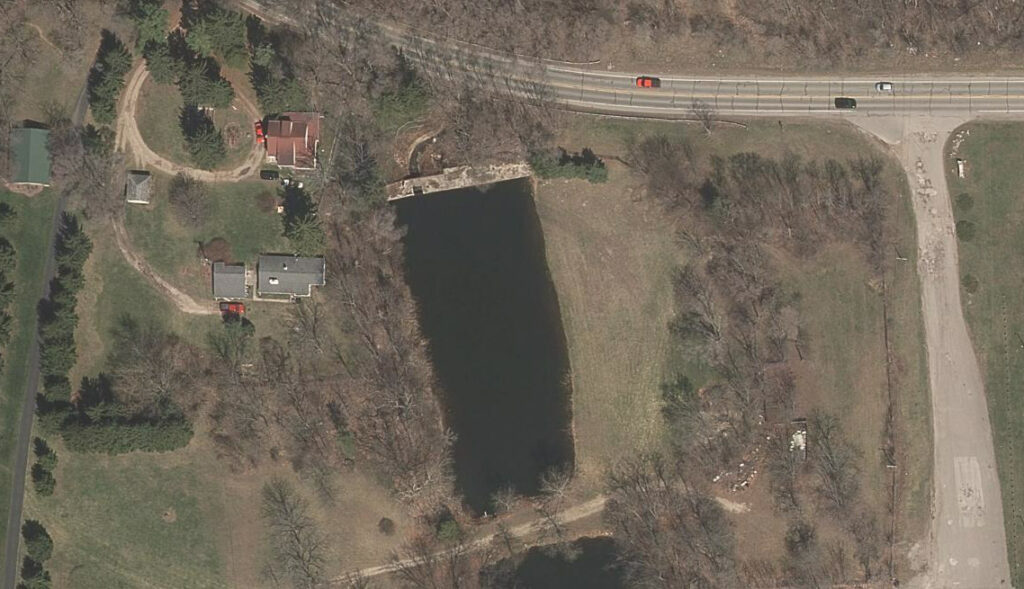
Local communities were once peppered with small, unique establishments such as this — essentially, private country homes that had, over time, become public. With a little imagination, these types of places might be considered the equivalent of the English public house (or pub), but in a different genre. Instead of a private urban home given over to the serving of beer and ale, Susterka Lake was a large, private property given over to swimming, skating, dancing, and hay rides — all, presumably, in exchange for a modest fee.
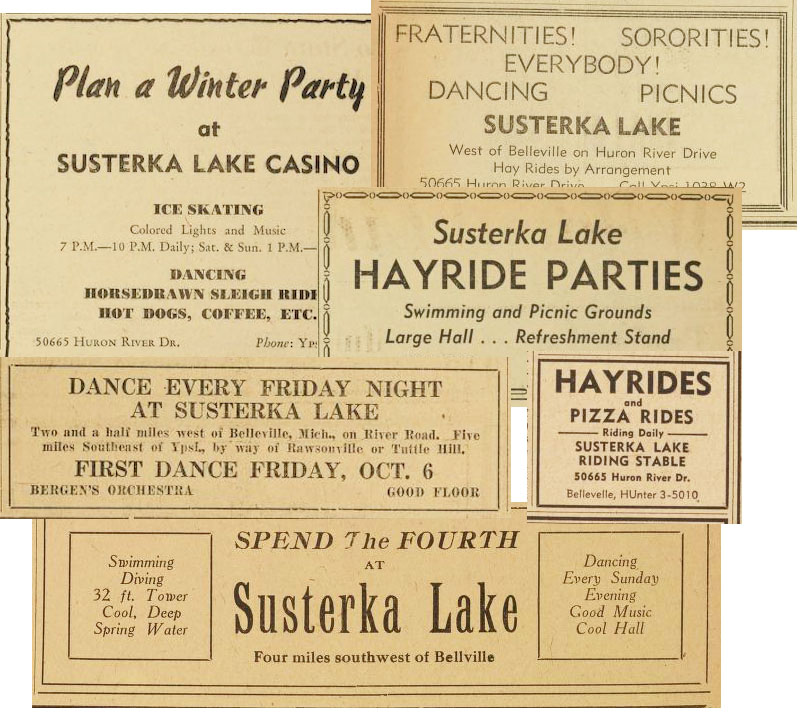
All of this began with a local farmer’s desire to grind chicken feed.
According to the local history book Water Under the Bridge by Cathy Horste and Diane Wilson, Anton Susterka was a Romanian immigrant who could recognize an opportunity.
Around the 1920s Mr. Anton Susterka, who was of Romanian descent, built a small dam and a water wheel on a creek on his property on Huron River Drive. In the Romanian tradition, the water wheel was very tall in order that it could catch a maximum amount of water, creating enough power for Mr. Susterka to grind chicken feed for local farmers. Mr. Susterka allowed local boys to swim and dive in the small but deep lake created by his dam. The boys firmly believed in the joys of skinnydipping in Susterka Lake, but when neighbors began to complain of this practice, Mr. Susterka required the boys to change into bathing suits inside his corn crib. So many boys began to utilize the changing room that Mr. Susterka figured that he might as well charge each one a dime for the privilege. With the proceeds from this small venture, Mr. Susterka was eventually able to build a dance hall in approximately 1923, which through the years has served as the scene of many a Saturday night dance and Eastern Michigan University fraternity party.
“Water Under the Bridge: A History of Van Buren Township,” by Cathy S. Horste and Diane F. Wilson, 1977 (p. 160-161).
Thus Mr. Susterka seems to have lived a proverb, by discovering that his prior business was (literally) chicken feed, compared to the much more lucrative business of entertainment.
Abandoned
Although I was born nearby, by the time I got my first pair of swim trunks, Susterka Lake had closed. But it had an inertia. As the origin of many a fond memory still lingering in the minds of the local population, it immediately began a second life, taking on the mystique that attends an abandoned place — where memory and mystery are left to mingle as they might, gradually transforming the lost into the legendary.
As a child, I was the perfect example of the crucible in which this transformation occurs. Almost every day, either my parents’ car or the school bus would conduct me through the little tree-shaded valley where, bored out of my mind, I would briefly glimpse the empty structures and the lonely diving platform, looming over the placid pond as we sped by. These images readily mixed with hazy recollections of the very earliest parts of my childhood, when Susterka Lake was perhaps still a real place, that my older brothers had actually visited, and would sometimes talk about.
It must have been in the mid-1970s, when Water Under the Bridge was being researched, that the photo below was taken, showing the “old” Susterka beach house, that attracted much curiosity besides my own.
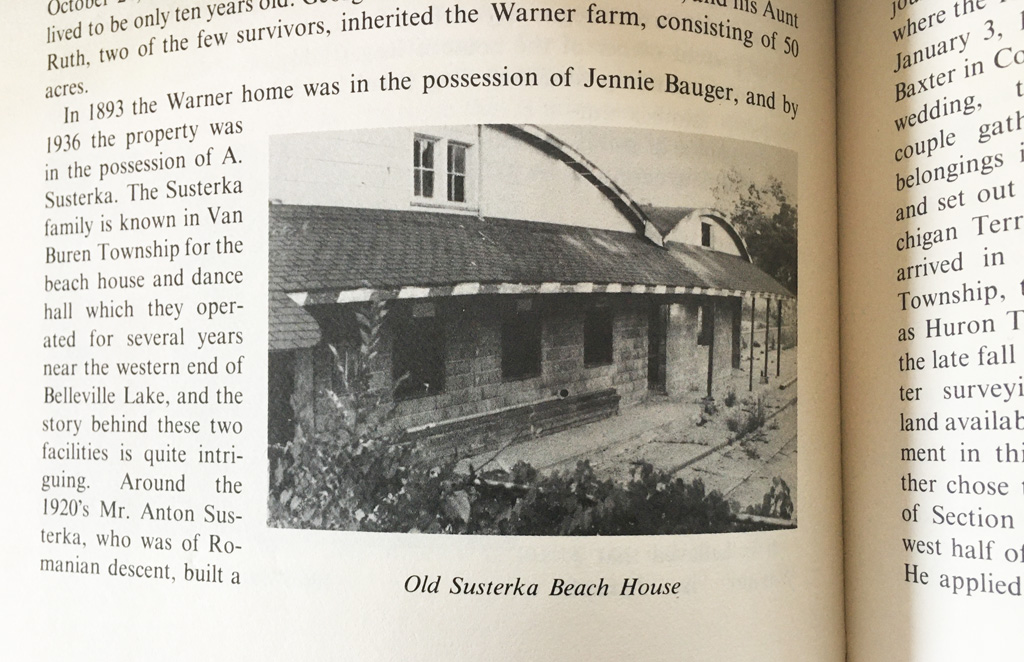
Soon afterward, the same economic influences that probably tanked Susterka Lake as a business would also lead my family to move far away, to a distant state, never to return. Susterka Lake thus came to occupy the same mental space I devote to thoughts of old amusement parks, empty houses and abandoned buildings — all of which I longed to explore in my childhood (and sometimes did) — but always eluded me as an adult.
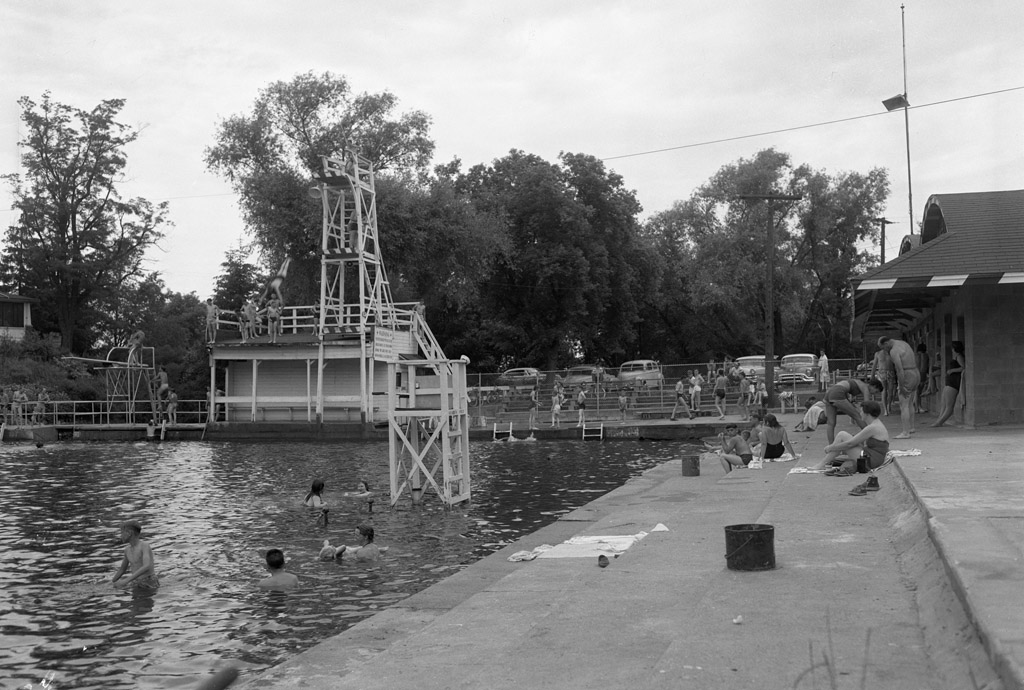
Years later
After a very long time, and many adventures elsewhere, another set of economic influences caused me to move back to this area. Susterka Lake once again resumed its daily taunt — on my daily commute, to and from work.
By now, the beach house and other buildings were long since demolished, and the beach, if it ever was a beach, was just a nondescript expanse of grass that gently sloped into the pond, where it met a fringe of cattails. The area was generally well kept, but there was nothing to suggest that this scene had ever witnessed anything notable at all.
One day, I decided to take a closer look. Although the amenities were gone, the pond indicated that the dam remained, and I was curious about whether I could make out any vestiges of the water wheel or the mill that Mr. Susterka had constructed. I stopped on a nearby shoulder, got out of my car, and walked a few hundred feet to the curving dip in the road where it looked out over the grounds.
It was a gray December day, and visibility was good because the leaves had all fallen. I could see the pond not far away. But because I was on foot at the road’s edge, I could now see much more than I ever had from the car.
In front of an overgrown dam topped by a cement walkway, there was a narrow spillway rushing with water, and a low, angular concrete wall branching off to the right. Brown with leaves, gray with aging concrete, and green with invasive English ivy, the scene was bleak. This was definitely not a going concern.
But water still raced eagerly along the intact spillway, oblivious to society’s turn of attention. This tiny force of nature seemed to be standing ready, loosened from its harness, but not yet freed — still poised, perhaps, to mill corn again someday.
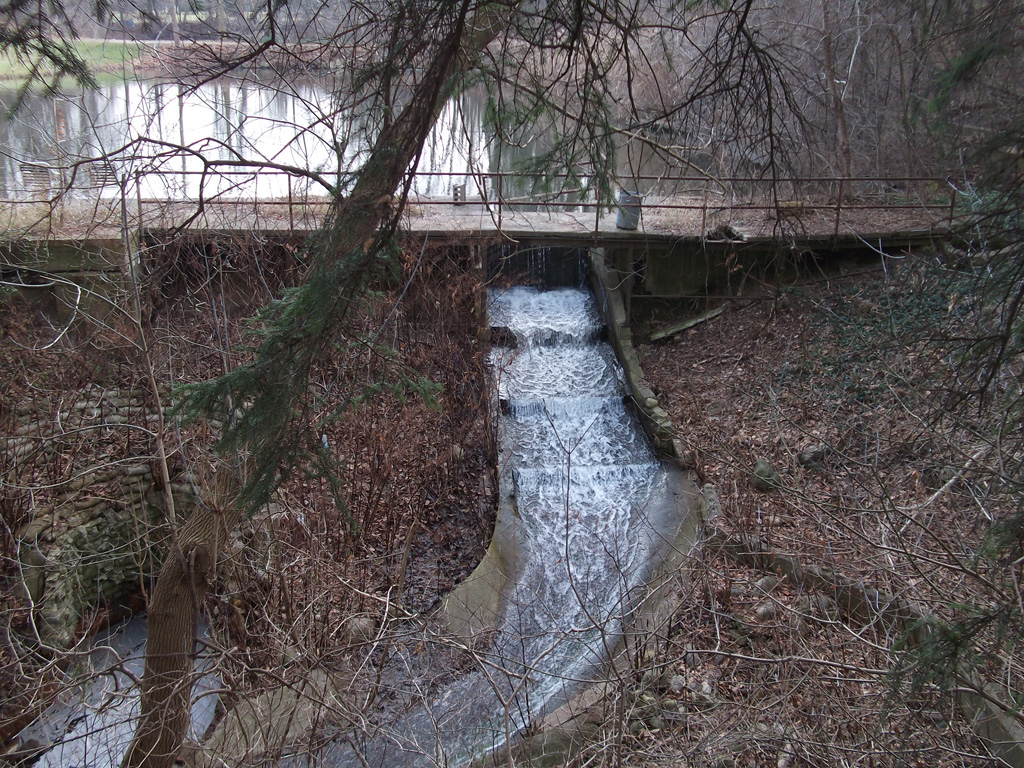
I surmised that the mysterious semicircular, vertical structure seen in the photo below, made of hardened bags of concrete mix, might have been associated with the “very tall water wheel” of the original mill. It’s hard to say. After briefly collecting there, the water exiting the spillway flows toward the viewer, into a culvert deep under the roadway, where it exits to form a small stream again, and rapidly descends to Belleville Lake.
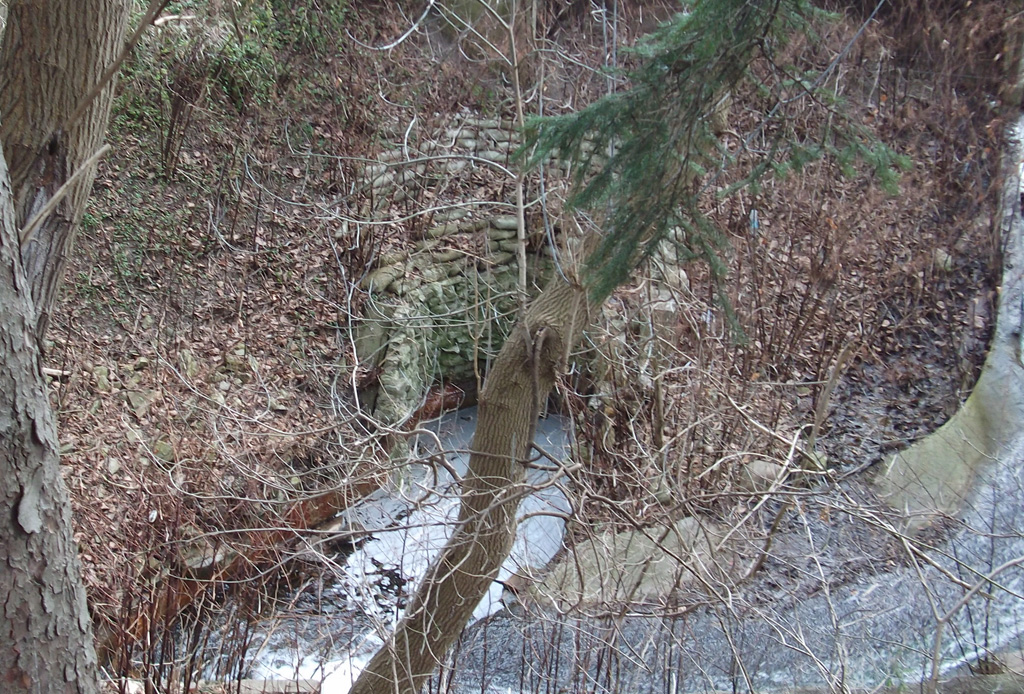
I was disappointed that the old mill had left only cryptic clues to its existence. However, now seeing the features of the area in front of the dam, I unexpectedly discovered the answer to something that I had wondered about for a long time.
A secret garden
My father was one of the many local people who had occasion to spend some time at Susterka Lake. In August of 1954, he took his year-old son — my oldest brother — for a visit there, along with a camera filled with Kodachrome color slide film. On that day, he took only two photos – one of my brother, and another of the scene below. In his slide index, this photo was titled, mysteriously, “Below Susterka Lake.”
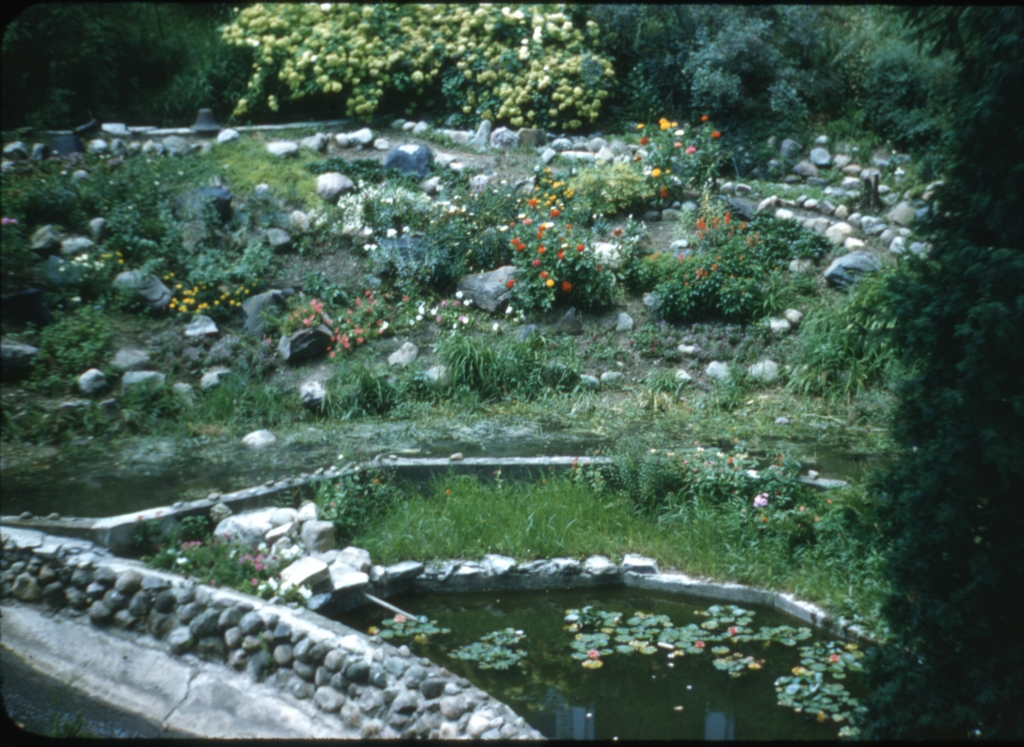
I had always been puzzled at the title. How could he have taken a picture below a lake? Wouldn’t that be underwater? And this didn’t look like Susterka Lake. It was just a rock garden somewhere. I half suspected he had simply mislabeled it in the slide index.
But now, I knew that this was actually a photo of the forlorn depression that I had just visited, below the dam. At one time, out of sight of the road and visible only to contemporary visitors like my father, a picturesque rock garden and lily pond was lovingly tended here. It was certainly the blooming flowers that led my father to take the picture.
For confirmation, I compared my new pictures to the old one. Although I could not take a picture from my father’s position on the dam, the angled concrete wall provides a common reference point. In the photos below, segments a, b, and c mark the same features.
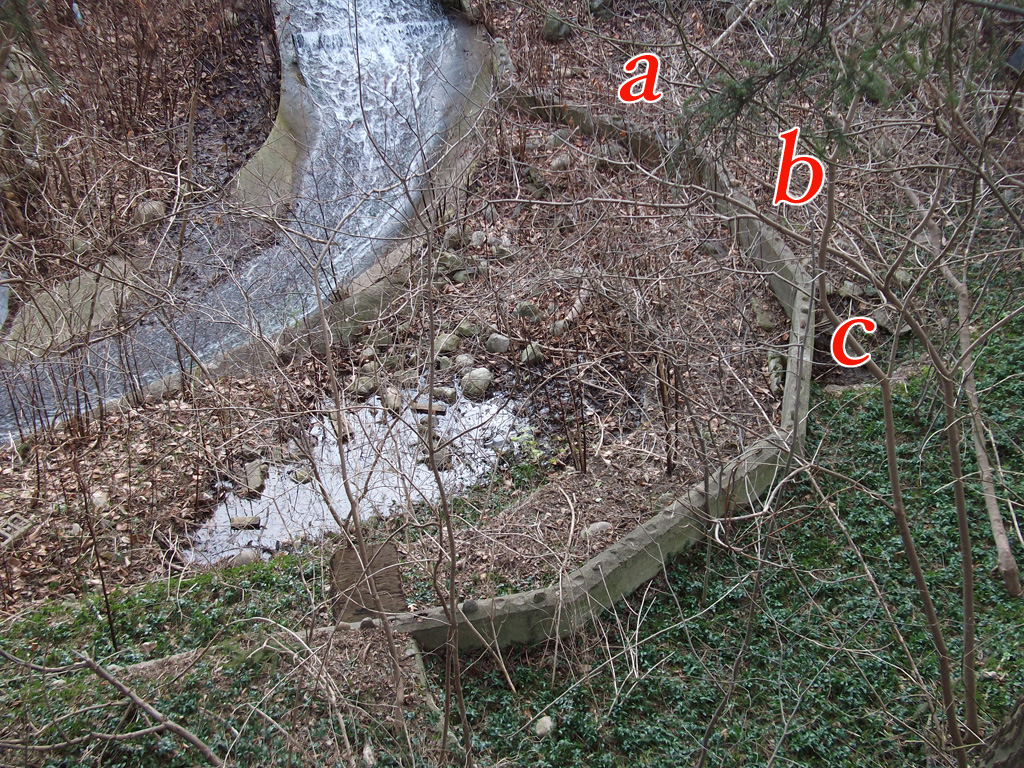
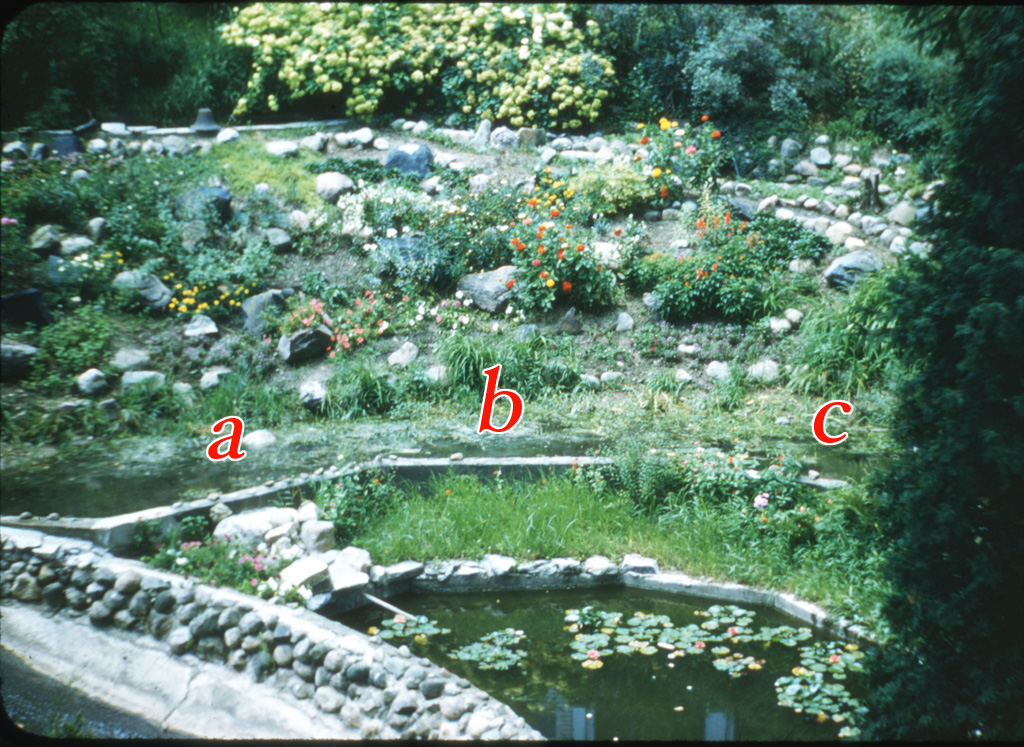
Back then, a selection of carefully tended flowers and field rocks formed a very nice rock garden on the sloping bank that rises up to the road. Below it, lily pads grew in what might have been a small koi pond, fed perhaps by a little water diverted from the spillway. Today, the lily pond is a marshy puddle filled with decades of leaf litter and a scattering of rocks likely fallen from other neglected features of the garden.
Interestingly, a close examination shows that the top of the angular wall (a-b-c) was once decorated with field stones, stuck slightly into the concrete when it was still wet. Looking at the “today” photo, we can see mostly just the indentations, where freeze-thaw cycles have caused the rocks to fall away. While it would be easy to assume that this happened over the 60 years between the old picture and the “today” picture, my father’s picture reveals that almost all of the displaced rocks had already fallen off by 1954. We can even see the single rock at segment “b” was already by itself, even then.
Echoes of an auto economy
While it was fun to view this scene in stereo time, and understand something more about that day in my father’s life, the story of Susterka Lake is also a good example of the process of economic abandonment, and failed succession of businesses, in the American midwest.
This area has dozens of examples of bygone businesses that fell aside as the local economy began to reel from decades of overreliance on the auto industry. Not only the dollars, but also the habits, of auto workers shaped many of these local businesses. I would speculate that many of the “picnics” that Susterka Lake hosted were spontaneous, casual affairs, either consisting of one or two autoworkers visiting during lunch hour from the Rawsonville Ford plant, or the families of said autoworkers bringing their children there on a weekend afternoon. I don’t know the business model by which picnics made money for the owners, but when you have 40 or more acres, it would probably have been enough to simply offer the space in the hopes that people would purchase food from the concession stand. Similarly, a little convenience store called Jim’s Market, half a mile further down the road, was built as an addition to an existing house and did a thriving business selling kielbasas and pizza slices to autoworkers on lunch break. It rapidly declined with the construction of other stores closer to the plant; a line of purchasers tried to continue operating the store, but it never thrived again. The building was demolished by the township in 2017, after lingering empty for a decade or more.
Susterka Lake’s business model appears to be a thing of the past. Even by the early 1970s, cultural shifts in modes of entertainment and changes in local demographics had weakened it to the point of failure. This was long before video games, cable television and streaming entertainment even came on the scene. Old timers recall that local children would often gather at Susterka Lake every morning, waiting for the swimming hole to open, some of them “working their way in” by performing clean-up tasks in lieu of the admission fee. In a culture centered on the LCD screen, this seems like a scene from Huckleberry Finn.
An attractive nuisance
Although on private property, it is likely that for a time after it closed, Susterka Lake and its empty buildings existed as something that city governments have come to call an attractive nuisance. This is a building, or other structure, that simultaneously attracts curiosity and also is considered to present a safety hazard to those it attracts. Certainly, a poorly secured, empty beach house, next to a pond full of turtles, both of which one’s parents and older siblings continue to talk about frequently, and both of which are now off limits, must have nourished many a child’s imagination on an idle summer day. I would speculate that this must have led to the owner’s decision to undertake a rather expensive demolition job — hastened, probably, by the township administration, and its emphasis on preventing blight over preserving history.
In fact, you might say that Susterka Lake was an attractive nuisance from the very beginning. Who, in this age of litigation and nervous parents, would ever allow random neighborhood children to swim, without a lifeguard, in his extremely deep mill pond? The liability insurance alone would put him out of business. But in the 1920s, things were seen differently.
Digital archaeology
My investigation into this bit of local history also demonstrates how the passage of time can make an abandoned institution disappear almost utterly and completely, leaving very little evidence to hint at its one-time prominence.
I have a vague recollection that one of my older brothers, as a teenager, may have taken his metal detector to the grounds of the Susterka beach house, in the expectation of finding coins. I don’t know if he had permission, or any success. Undoubtedly, many tangible artifacts of fifty years of diving swimmers and casual picnickers must lie beneath the waters of the pond or the grass of the 40 acres of fields that surround it.
Today, when we want to dig in to the history of a place, we have the option of doing some virtual digging, online, instead. Thankfully, “Susterka Lake” is such a unique name that an online search will reveal almost everything that the internet knows on the topic. But there isn’t very much. The top hit is a seemingly unmaintained lake database website, that happens to have collected a few undated reminiscences from random visitors who have stumbled upon it over the years.
Beyond these scattered references, and the newspaper ads shown above, and a brief mention in a local history book, I found almost nothing more. The internet yields hundreds of auto-generated pages that duly acknowledge Susterka Lake as a place name or a lake name, but relatively little evidence of its time as a popular business and meeting place. Apparently, those with first-hand knowledge of this place have not made it to the internet in great numbers, instead passing down their memories to the trust of younger relatives, who are not posting much about it. A few digitized newspapers of long ago may end up being all that keeps its memory from slipping away.
Finding a match
I did manage to find exactly two pieces of physical evidence that support the existence of Susterka Lake: two matchbook covers offered by two different vendors on eBay. That was it — besides these two items, there was not even a record of anything matching the term “Susterka Lake” even having been sold on eBay in the recent past.
They were super cheap, so I bought them both.
In the first matchbook cover, shipped from Colorado, we see an old-fashioned telephone number, in which the prefix is “Ypsilanti” and the six-digit number oddly includes a letter. This, together with the graphics, suggests that this matchbook might date to the 1940s or earlier. Here we see again that it was not just a swimming hole, but also the site of picnics and hayrides in the summer. In the winter it also diversified with ice skating, sleigh rides, and of course the indoor festivities made possible by the dance hall.
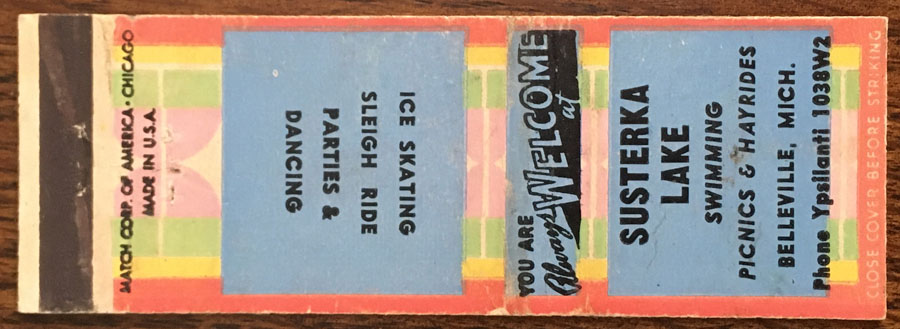
The second matchbook cover, below, was shipped overseas from London, UK. Here we see a more modern 7-digit phone number (with the two-letter prefix that was common notation up to the early 1970s). Judging from that, and some evidence that its manufacturer Mercury Match Company operated between 1946 and 1956, I would guess that it dates from the 1950s. It could have been sitting on the counter of the concession stand when my father took his picture, below the lake.
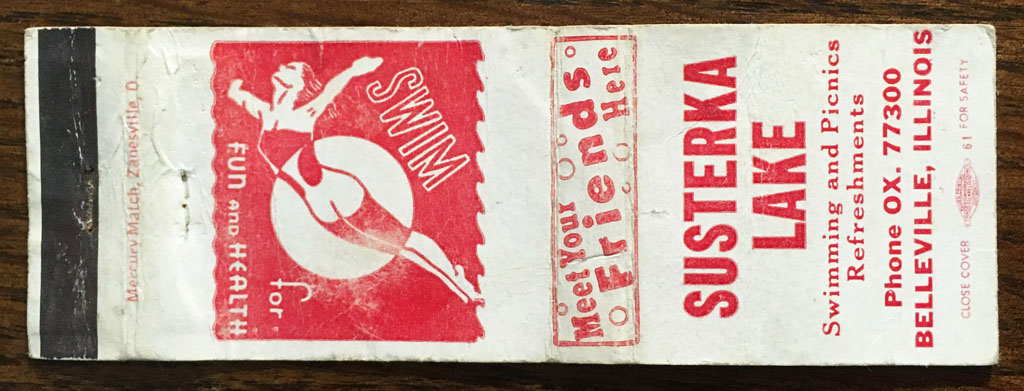
But wait — Belleville, Illinois? Susterka Lake was in Michigan! It appears that we have rediscovered a long forgotten, and rather glaring, mistake on the part of the printer. Yes, there is a Belleville, Illinois — a somewhat sizeable city that was probably more familiar to the inattentive typesetter than the tiny, obscure one in Michigan.
If Mr. Susterka was upset about his misprinted matchbooks, there is no evidence of it. He apparently used them anyway.
But we know that this is obviously a printer’s mistake, because the “OX” prefix of the phone number is correct for the Michigan town.
And because, of course, as everyone knows — there was only one Susterka Lake.
Article and photos Copyright 2022 by the author.
Photo of Susterka Lake swimming pool in 1954 Copyright Ann Arbor News. Fair use assumed to apply.
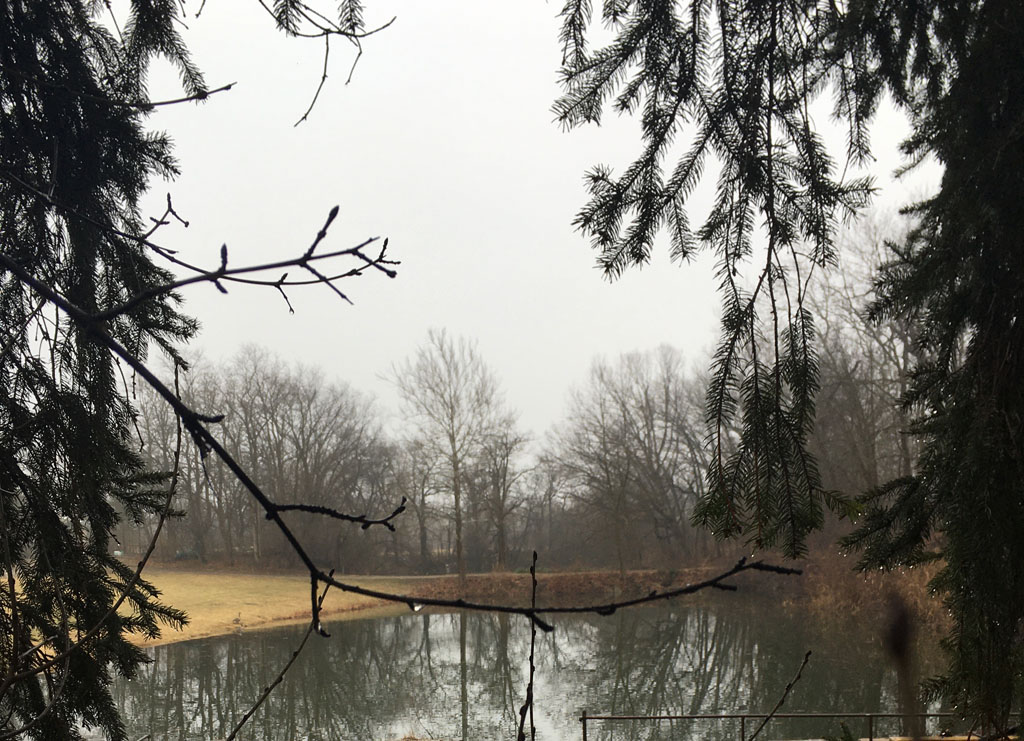


17 Comments
Diane Hardy
I am so glad you published this article along with the pictures! When I was a kid, sometime between 1959 and 1961, my dad took me and my mom to see Susterka. One day, years later,my asked my dad what that place was where he took us. He told me the name but I had forgotten it until one of my older cousins was in town and we talked about it. She remembered the name but I still didn’t know exactly where it was. Now that I know my husband and I will search out the area the next time we are in Belleville. Thanks again!
Paul Steen
Thanks for the insights into our local history! This is very neat and makes one yearn for those simpler days. Though nostalgia does tend to be rather inaccurate… Still, I appreciate getting a glimpse into how people lived 60 years ago.
Cindy Susterka (Hayes)
Being of the family of Susterka, I might be able to put a few pieces together for you that might be missing.
Mike
Thanks Cindy, please do! You can post here, or contact me at: editor ‘at’ whatshallweweird dot com.
Sheila Visingardi
My in-laws owned Jim’s Market. They owned that corner from 1958-1983 when the family retired. Jim was 59 and ready to retire. He enjoyed his time serving their food to the community. The store was then sold to an individual who took the store on his own journey.
Collectively as a family with their workers they made their locally famous pizzas for the Strawberry festival for decades. They were donated to Saint Anthony’s to raise money!
Beverley enjoyed her retirement . She filled her free days visiting with friends and sometimes even playing golf. The Bastedo, Capili, Grillo, as well as many others starred in life stories shared to me via Beverley. Jim would do the same along with being a member of Belleville’s Lion club, playing racquetball in the gym that is now the old Diamondback, as well as visiting Vic Tally’s daily!
They were married from April 1953 until Beverley’s passing in April of 2001. They just missed their 48th anniversary by 18 days. Jim passed in Jujy of 2007.
Together while owning their store, they raised six children, were blessed with so many grandchildren and their union lives on with the now THIRD generation of Visingardi offspring/grandchildren being born and raised.
My husband and I took the family’s Italian pizza recipes and opened a few stores before finding our “home” in Westland. From 1953 to 2023, we continue the family’s 70th year serving the public the familia’s Italian pizzas!
Thank you for posting this article
Mike
Thanks so much Sheila! This history of Jim’s Market is fascinating to me. I was just a tiny kid so I never really knew Jim but I remember the kielbasas on a homemade bun, and the pizzas, strombolis too maybe, I seem to remember they were mostly to go, wrapped in plastic wrap under a heat lamp in a big glass counter at the right side of the store near the front and there were always people buying them. Sometimes he had a lot and sometimes he was almost sold out. I think he also had uncooked pizzas that you could take home and bake. Really cool that the tradition lives on in Westland. We lived nearby and it was always on the way home so we got all our candy and pop and baseball cards from Jim’s, except I don’t think he had comics, which we had to get at Hayward’s. After we moved away, I visited once in the 80s and I swear it was still the same lady working the checkout — she had a distinctive way of saying “Something else?” when she had totaled it up and you were ready to pay. At some point it changed to John’s Market, then something like Huron Party Stop – but these were more like the typical party stores, never really the same.
Lila Van Assche
I was taught how to swim here in Susterka Lake by my two older brothers, mid 1950s. I was about 4 or 5 years old.
Michelle Donders
I used to rent horses at Susterka Stables with my girlfriend when visiting my grandparents in Belleville. It was around 1968-1970. I don’t see any mention of the stables in this article. Is it connected in anyway?
Mike
Michelle, some of the old newspaper ads at the top of the article do mention hayrides and a riding stable so I would say this was definitely the same place!
Mary Corso
My family used to swim there, at that time a good friend of my Aunt Mildred 0wned iit, the Bastedos, they had 3 sons and a daughter, (Bill, Larry, Gary and Lisa) Bill ran the riding stable, there also was a wishing well by the spillway, and they would have diving competition at the lake, it was booming back in the 50 and 60, he then built the golf course
Mary Corso
My Brother Larry did some welding on the big swing, Elenor Bastedos was the Maid of Honor in my Aunt Mildred’s wedding, thank you for printing this article, my cousin Vicky has a lot of pictures of the lake
Mary Corso
Mike can you do an article on the Homes Lost in the Making of I 275 and Willow Metro Park? There were a lot of Families that lost their homes due to that progress, Our home was one, can you dig up anything?
Mike
Thanks Mary! So then it was a wishing well that was below the dam, that’s helpful to understand why the garden was there.
Mike
Mary, thanks for the suggestion on I-275 and Willow metropark. I certainly don’t see much on the internet about that at all, so any additional details would be helpful.
merle penny
I only heard about sister go through an older friend I was too young to enjoy going over there to swim in the early 60s
merle penny
Thank you for finding out all this information and putting it online, I go right by there almost daily I knew where it was and each time I go by my curiosity needs to be answered
Donna Pullen
I lived down the road from Susterka lake/Stables. I grew up with the Bastado family. Don Bastado would go sailing with my dad, Don sang very loudly as they sailed along.
I shoveled horse poop so I could ride at no cost 🤣🙆🏻♀️.
Larry, Gary these were some of the best days of my life ❤️.